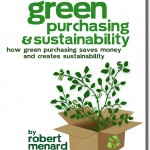Preview, Green Purchasing and Sustainability, Chapter 4
Editor’s note: this is the fourth of eight chapter previews of the new workbook and manual, Green Purchasing and Sustainability, that will be available to order in July 2011. To see all chapter previews, click here.
Concrete
Concrete is a mixture of approximately 85% sand and gravel, 15% Portland cement, and water. Portland cement, for real and/or exaggerated reasons, is the most notorious of concrete’s ingredients in a sustainability context.
Cement production creates a dual impact on sustainability in terms of GHG emissions. Huge amounts of all fossil and other fuels are consumed to fire up the 3,000 degree F kilns needed to breakdown the limestone, the predominant raw material. Limestone is principally a composed of Calcium (Ca) and Carbon-Oxide compounds, mostly CaCO3. When limestone is heated, it liberates CO2 in the approximate proportion approximately one ton of CO2 for every ton of cement created. Thus, the cement industry looms large in the cross hairs of many so called environmentalist organizations.
High on the hierarchy of ironies, CO2, despite being identified by some, including the EPA, as an atmospheric pollutant, is a requirement for animal life on earth. Vegetation ingests CO2 as part of the photosynthesis process and gives off the waste product of oxygen. The waste of the flora world is the breath of the fauna world and vice versa. Both CO2 and oxygen are needed for the earth to sustain. However, the mandate of reducing GHG emissions is not likely to go away and thus must be incorporated into any sustainability program.
As with global warming claims, there is no clear and convincing body of evidence on the effect that man made GHG do or do not have as alleged by the sides in this argument. It is a fact, however, that the planet’s human population is growing exponentially. As such, civilization will need more concrete and cement, the universal building material of all humanity.
 Energy intensive industries like electrical power generation, cement, steel, and others consume enormous amounts of fossil fuels like coal, coke, oil, and gas, etc. These fuels are more Btu intensive per dollar than other fuels. They are also more emission intensive so herein lay the balancing act.
Energy intensive industries like electrical power generation, cement, steel, and others consume enormous amounts of fossil fuels like coal, coke, oil, and gas, etc. These fuels are more Btu intensive per dollar than other fuels. They are also more emission intensive so herein lay the balancing act.
Some cement and power plants also burn waste of all kinds from scrap lumber, corrugated products, skis, nut shells, shredded tires, waste oils, and other combustibles including dehydrated sewerage. Technology is ever improving to limit atmospheric contaminants in the form of GHG and particulate matter. Many are reclaimed and treated.
Produced at a rate of about 25 billion tons per year and growing, concrete requires a tremendous amount of energy to produce, transport, and maintain. Cement production may create substantial GHG, but how does that work out over its life time? Concrete is not fully recognized by the any existing standards for its durability. Put in the language of sustainability, its Life Cycle Assessment has yet to be fully recognized.
To make the point consider this one amazing statistic: A typical family car produces 11,760 lbs of CO2 per year. The concrete driveway it parks on, measuring approximately 24’ X 50’ produced 5,880 lbs of CO2 the one time its cement was manufactured. The car produces twice as much CO2 every year. And, over a 30 year life span of the driveway, the concrete’s contribution to GHG shrinks to less than 200 pounds per year, an amazing 60 times less that the car every year.
